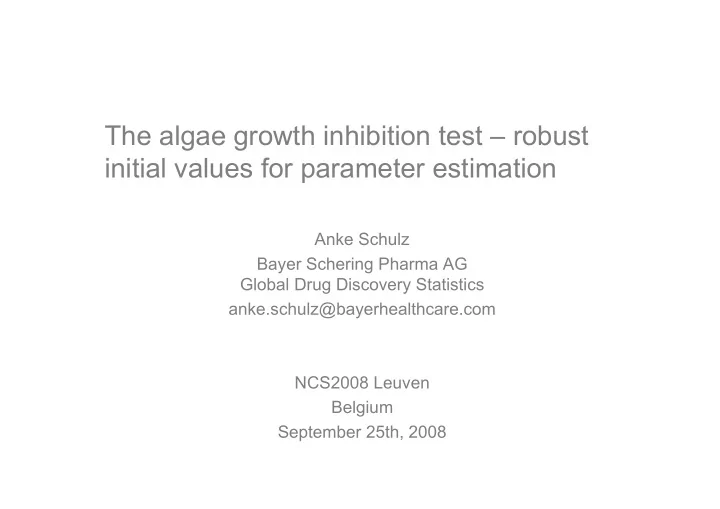

The algae growth inhibition test – robust initial values for parameter estimation Anke Schulz Bayer Schering Pharma AG Global Drug Discovery Statistics anke.schulz@bayerhealthcare.com NCS2008 Leuven Belgium September 25th, 2008
Overview 1 The algae growth inhibition test 2 Four-parameter logistic regression model 3 Initial values for iterative estimation procedure 4 Application NCS2008 Leuven, September 25th, 2008 Anke Schulz
1 The algae growth inhibition test Design • Biological test to investigate the growth inhibition of algae under addition of a substance. • Test routinely used in toxicology. • Design: - One control group (usually six replicates). - Several dose groups of the same substance (usually five dose groups in dilution series with three replicates). - Equidistant time points starting at 0h (usually 0, 24, 48 and 72). NCS2008 Leuven, September 25th, 2008 Anke Schulz
1 The algae growth inhibition test Biomass integral • Algae biomass is a function over time for each replicate. • The growth is measured by the integral of the biomass. → This integral will be the variable of interest. biomass biomass integral time point NCS2008 Leuven, September 25th, 2008 Anke Schulz
1 The algae growth inhibition test Data • Integral of biomass decreases by dose (in dependence on toxicity). biomass integral dose NCS2008 Leuven, September 25th, 2008 Anke Schulz
2 Four-parameter logistic regression model Logistic regression model • Sigmoid model: • Four-parameter logistic regression model: resp res.max b res.min dose ED50 NCS2008 Leuven, September 25th, 2008 Anke Schulz
2 Four-parameter logistic regression model Iterative parameter estimation • The non-linearity of the model requires an iterative parameter estimation procedure and initial values. • The convergence behavior depends on the choice of initial values. • For small variation , procedures to obtain initial values developed by (Normolle, 1993) and (Ritz and Streibig, 2005) work very well. • For large variation as found in the data of the algae test: – Robust M-estimators proposed by Huber (1964). – Our new robust procedure (2006) including an automated determination of initial values. NCS2008 Leuven, September 25th, 2008 Anke Schulz
3 Initial values for iterative estimation procedure Parameters res.min and res.max • The initial values for the parameters res.min (minimum) and res.max (maximum) will be estimated as described by Ritz and Streibig (2005): • However, initial values for res.min ini and res.max ini have only a limited impact on the convergence. NCS2008 Leuven, September 25th, 2008 Anke Schulz
3 Initial values for iterative estimation procedure Parameters b and ED50 • Estimators for parameters b (slope) and ED50 do have a functional relationship. • If initial value for ED50 is inaccurate, i.e. | ED50 ini - ED50 |>>0, parameter estimates for b and ED50 are unreliable. Then, the sign of the slope changes. • Consequently, a reasonable dose interval for ED50 ini has to be found. NCS2008 Leuven, September 25th, 2008 Anke Schulz
3 Initial values for iterative estimation procedure Parameters b and ED50 • Middle response= . . • Dose interval= [largest dose with all biomass observations above the middle initial value response ; for res.max smallest dose with all observations below the middle middle response response]. ED50 ini : weighted mean of the • dose of the observations of the initial value interval. for res.min – Weight depends on the dose distance to the middle response. NCS2008 Leuven, September 25th, 2008 Anke Schulz
3 Initial values for iterative estimation procedure Parameters b and ED50 • Based on the initial values for res.max , res.min and ED50 , initial value for parameter b is calculated for each observation (Normolle, 1993): • For a first quality check of initial values, the sign of b ini is compared to the sign of the slope parameter of a simple linear regression (negative sign of b corresponds to a positive slope). NCS2008 Leuven, September 25th, 2008 Anke Schulz
3 Initial values for iterative estimation procedure Parameters b and ED50 • If the sign of b ini does not match the direction of the slope: – The sign of b ini is changed. – The parameter ED50 ini is calculated for each observation based on the initial values for res.max , res.min and b . – Median of all ED50 j is the new initial value for ED50 . – b ini is calculated again. NCS2008 Leuven, September 25th, 2008 Anke Schulz
4 Application Practical experience • Our proposed approach is tested on 42 real data sets. • Common procedures lead to poor results, only 70% of all estimates are reasonable. • Instead, our initial values yield sensible parameter estimates in all cases. NCS2008 Leuven, September 25th, 2008 Anke Schulz
4 Application Example Blue: Model of initial values response [biomass integral] dose [mg/l] NCS2008 Leuven, September 25th, 2008 Anke Schulz
4 Application Example Blue: Model of initial values Green: Estimated model response [biomass integral] dose [mg/l] NCS2008 Leuven, September 25th, 2008 Anke Schulz
4 Application Example Blue: Model of initial values Green: Estimated model response [biomass integral] Red: Model of initial values (Normolle, 1993) dose [mg/l] NCS2008 Leuven, September 25th, 2008 Anke Schulz
References • Huber, P.J. (1964). ‘Robust estimation of local parameter’ . Annals of Mathematical Statistics 35: 73-101 . • Normolle, D.P. (1993). ‘An Algorithm for Robust non-linear Analysis of Radioimmunoassays and other Bioassays’. Statistics in Medicine 12: 2025-2042 • Ritz, C. & Streibig, J.C. (2005). ‚Bioassay Analysis using R’. Journal of Statistical Software 12, Issue 5. • Schulz, A (2006). ‘Das vierparametrische logistische Modell und seine Anwendung bei einem ökotoxikologischen Problem’. Master Thesis. Humboldt-Universität zu Berlin, Germany. NCS2008 Leuven, September 25th, 2008 Anke Schulz
Recommend
More recommend